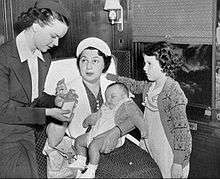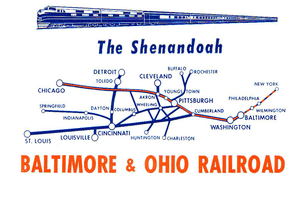Shenandoah (B&O train)
The Shenandoah was an American named passenger train of the Baltimore and Ohio Railroad (B&O), one of four daily B&O trains operating between Jersey City, New Jersey and Grand Central Station in Chicago, Illinois, via Washington, D.C. and Pittsburgh, Pennsylvania from the 1930s to the 1950s. Other B&O trains of that period on the route were the Capitol Limited, Columbian, and the Washington - Chicago Express.[1] An alternate branch originated in Detroit and met with the Chicago part of the train at Deshler, Ohio, south of Toledo.
.jpg)
While the trains were advertised as beginning in New York City, they actually began in Jersey City. at the Jersey Central's Jersey City terminal, where passengers were then transferred to buses that met the train right on the platform. These buses were ferried across the Hudson River into Manhattan, where they proceeded to various "stations." After April 26, 1958, the B&O no longer operated passenger trains north of Baltimore, Maryland, which then became the eastern terminus of the Shenandoah for the remainder of its existence.[1]

From the 1940s to the 1960s, the daily Shenandoah consisted of coaches, five Pullman sleeping cars, a lounge car with a radio, and a full-service dining car. Beginning in the early 1950s, the train also had a Strata-Dome combination sleeper-dome car on alternate days.[2][3]
The westbound Shenandoah, operating as Train #7, left Washington at 11:30 p.m. (several hours after the 5 p.m. departure of the Capitol Limited and Columbian from the nation's capital), making it a favorite of travelers seeking convenient connections with other railroads in Chicago, including the streamliners of the Santa Fe and Union Pacific Railroads.[2] The train also carried a heavy volume of mail and express, with "head-end" equipment such as Railway Post Office cars a regular part of the Shenandoah's consist.[2]
The Shenandoah operated to New York City via Philadelphia, Pennsylvania, until April 26, 1958, when the B&O discontinued passenger service north of Baltimore.[4] As passenger patronage on American railroads continued to decline in the 1960s, the combination sleeper-dome and dining cars were dropped, and Trains #7–8 were renamed the Diplomat in 1964 and then dropped altogether in 1967.[2] It had its final run in a truncated Akron, Ohio to Washington, D.C. itinerary with the end of B&O passenger service on April 30, 1971[5]
Amtrak revived the name in the 1970s for the short-lived Shenandoah, a Washington—Cincinnati train.
Schedule
In 1961, westbound Shenandoah Train # 7 operated on the following schedule (departure times at principal stops shown):

| City | Departure time |
|---|---|
| Baltimore, Md. (Camden Station) | 10:00 p.m. |
| Washington, D.C. (Union Station) | 11:15 p.m. |
| Martinsburg, W. Va. | 12:56 a.m. |
| Cumberland, Md. | 2:47 a.m. |
| Connellsville, Pa. | 5:10 a.m. |
| McKeesport, Pa. | 6:08 a.m. |
| Pittsburgh, Pa. ((P&L.E. Station)) | 7:00 a.m. |
| Youngstown, Ohio | 8:36 a.m. |
| Akron, Ohio (Union Station) | 9:52 a.m. |
| Gary, Ind. (CT) | 2:38 p.m. |
| Chicago (Grand Central Station) | 3:45 p.m. |
| source: B&O timetable, October 29, 1961[3] | |
References
- Herbert H. Harwood, Jr., Royal Blue Line. Sykesville, Maryland: Greenberg Publishing, 1990 (ISBN 0-89778-155-4).
- Harry Stegmaier, Baltimore & Ohio Passenger Service, Vol. 2 – Route of the Capitol Limited. Lynchburg, Va.: TLC Publishing, 1997 (ISBN 1-883-089-00X).
- Baltimore & Ohio — Passenger Train Schedules, October 29, 1961.
- Stephen J. Salamon, David P. Oroszi, and David P. Ori, Baltimore and Ohio — Reflections of the Capitol Dome. Silver Spring, Maryland: Old Line Graphics, 1993 (ISBN 1-879314-08-8).
- Edmonson, Harold A. "Trains on the eve of Amtrak", Journey to Amtrak, reprinted by Kalmbach Publishing, 1972.
